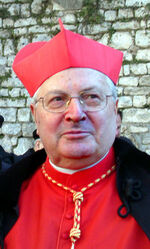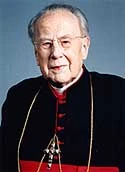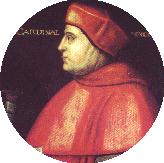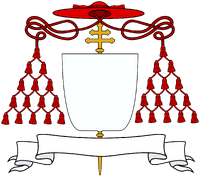| Part of the series on Cardinal (Catholicism) | |
|---|---|
| Coat of Arms | |
| The coat of arms of a cardinal are indicated by a red galero (wide-brimmed hat) with 15 tassels on each side (the motto and escutcheon are proper to the individual cardinal). | |
| College and orders of cardinalate | |
| Titular church | |
| Title and reference style | |
| Orders | |
| Special types of cardinals | |
| Cardinals in pectore or secret cardinals | |
| Vesture and privileges | |
| Cardinals in popular culture | |
| Article discussion | |
Cardinal bishop[]
Cardinal bishops, or cardinals of the Episcopal Order, are among the most senior prelates of the Catholic Church. Since most cardinals are also bishops, the title of cardinal bishop only means that the cardinal in question holds the title of one of the "suburbicarian" sees — they include the Dean of the College of Cardinals — or is a patriarch of an Eastern Catholic church.
The cardinal bishops are the only order of cardinals who have always been required to be bishops, and in former times when a cardinal of one of the lower orders became a cardinal bishop, and so the head of a diocese, he was consecrated a bishop. Since 1962 all cardinals have been required to receive episcopal consecration unless they were granted an exemption from this obligation by the Pope; however, since each of the suburbicarian sees are now each headed by their own bishop and not the cardinal bishops themselves, theoretically, a cardinal could now occupy any rank within the Sacred College without receiving episcopal consecration.

Cardinal Angelo Sodano, current Dean of the College
The Dean, the head (as primus inter pares) of the College of Cardinals, is elected by the cardinal bishops holding suburbicarian sees from among their own number, an election, however, that must be approved by the pope. Formerly the position of Dean belonged to the longest-serving of the cardinal bishops, all six of whom then headed a suburbicarian see. Though these sees are now seven (Ostia and Velletri having been separated in 1914), there are only six cardinal bishops, since the Dean always adds the title of Ostia to his original suburbicarian diocese.
In early times the privilege of papal election was not reserved to the cardinals, and for centuries the pope was customarily a Roman priest and never a bishop from elsewhere; to preserve apostolic succession the rite of consecrating the pope as a bishop had to be performed by someone who was already a bishop. The rule remains that, if the person elected pope is not yet a bishop, he is consecrated by the Dean of the College of Cardinals, the Cardinal bishop of Ostia.
Currently the cardinal bishops of the suburbicarian diocese are:
- Angelo Sodano, Cardinal Bishop of Ostia and Albano, Dean of the College of Cardinals, former Cardinal Secretary of State
- Roger Etchegaray, Cardinal Bishop of Porto-Santa Rufina, Vice-Dean, President emeritus of the Pontifical Council for Justice and Peace
- Giovanni Battista Re, Cardinal Bishop of Sabina-Poggio Mirteto, Prefect of the Congregation for Bishops
- Francis Arinze, Cardinal Bishop of Velletri-Segni, Prefect Emeritus of the Congregation for Divine Worship and the Discipline of the Sacraments, widely regarded as the most Papabile African
- Tarcisio Bertone, Cardinal Bishop of Frascati, Cardinal Secretary of State and Camerlengo of the Holy Roman Church
- José Saraiva Martins, Cardinal Bishop of Palestrina, Prefect Emeritus of the Congregation for the Causes of Saints
For a period ending in the mid-20th century, long-serving cardinal priests were entitled to fill vacancies that arose among the cardinal bishops, just as cardinal deacons of ten years' standing are still entitled to become cardinal priests. Since then, cardinals have been advanced to cardinal bishop exclusively by Papal appointment.
In 1965 Pope Paul VI decreed in his motu proprio Ad Purpuratorum Patrum that patriarchs of the Eastern Catholic Churches who were named cardinals would also be part of the episcopal order, ranked after the six cardinal bishops of the suburbicarian sees (who had been relieved of direct responsibilities for those sees by Pope John XXIII three years earlier). Not holding a suburbicarian see, they cannot elect the dean nor become dean. The three Eastern patriarchs who are now cardinal bishops are the following:
- Ignace Daoud, Prefect emeritus of the Congregation for the Oriental Churches, Patriarch Emeritus of Antioch for the Syrians
- Nasrallah Sfeir, Patriarch of Antioch for the Maronites
- Emmanuel III Delly, Patriarch of Babylon for the Chaldeans
The Latin Rite Patriarchs of Lisbon and Venice, while in practice always made cardinals at the consistory after they take possession of their sees, are made cardinal priests, not cardinal bishops. Although the incumbents of such prestigious sees are usually created cardinal, no see carries an actual right to the cardinalate.
Cardinal priest[]

Franz König, former Cardinal Protopriest
Cardinal priests are the most numerous of the three orders of cardinals in the Catholic Church, ranking above the cardinal deacons and below the cardinal bishops. Those who are named cardinal priests today are generally bishops of important dioceses throughout the world, though some hold Curial positions.
In modern times the name "cardinal priest" is interpreted as meaning a cardinal who is of the order of priests. Originally, however, this referred to certain key priests of important churches of the Diocese of Rome, who were recognized as the cardinal priests, the important priests chosen by the pope to advise him in his duties as Bishop of Rome (the Latin cardo means "hinge"). Certain clerics in many dioceses at the time, not just that of Rome, were said to be the key personnel — the term gradually became exclusive to Rome to indicate those entrusted with electing the bishop of Rome, the pope.
While the cardinalate has long been expanded beyond the Roman pastoral clergy and Roman Curia, every cardinal priest has titular church in Rome, though they may be bishops or archbishops elsewhere, just as cardinal bishops are given one of the suburban dioceses around Rome. Pope Paul VI abolished all administrative rights cardinals had with regard to their titular churches, though the cardinal's name and coat of arms are still posted in the church.
While the number of cardinals was small from the times of the Roman Empire to the Renaissance, and frequently smaller than the number of recognized churches entitled to a cardinal priest, in the 16th century the College expanded markedly. In 1587 Pope Sixtus V sought to arrest this growth by fixing the maximum size of the College at 70, including 50 cardinal priests, about twice the historical number. This limit was respected until 1958, and the list of titular churches modified only on rare occasions, generally due to a building falling into disrepair. When Pope John XXIII abolished the limit, he began to add new churches to the list, which Popes Paul VI and John Paul II continued to do. Today there are close to 150 titular churches, out of over 300 churches in Rome.
The cardinal who is the longest-serving member of the order of cardinal priests is titled cardinal protopriest. He had certain ceremonial duties in the conclave that have effectively ceased because he would generally be over the age of 80, past which cardinals are barred from the conclave. The current cardinal protopriest is Eugênio de Araújo Sales of Brazil.
Cardinal deacon[]

Cardinal Wolsey
The cardinal deacons are the lowest-ranking cardinals. Cardinals elevated to the diaconal order are either officials of the Roman Curia or priests elevated after their eightieth birthday. Bishops with pastoral responsibilities on the other hand are created cardinal priests.
Cardinal deacons derive originally from the seven deacons in the Papal Household and the seven deacons who supervised the Church's works in the districts of Rome during the early Middle Ages, when the Church administration was effectively the government of Rome and provided all social services. Cardinal deacons are given title to one of these deaconries. There were traditionally 14 cardinal deacons, but this number has been expanded in recent years.
Under the 1587 decree of Pope Sixtus V that fixed the maximum size of the College of Cardinals, there were 14 diaconates. Later the number increased. As of 2005, there were over 50 recognized titular diaconates, though only 30 cardinals were of the order of Deacons. Cardinal deacons have long enjoyed the right to "opt for the order of cardinal priests" (optazione) after they have been cardinal deacons for ten years. They may on such elevation take a vacant title (church allotted as the titular dignity of a cardinal priest) or their existing diaconate may be elevated to title for that occasion. When elevated to cardinal priests, they take their precedence according to the day they were first made cardinal deacons (thus ranking above cardinal priests that were elevated to the college after them, regardless of order).
When not celebrating Mass but still serving a liturgical function, such as the semiannual Urbi et Orbi Papal Blessing, some Papal Masses and some events at Ecumenical Councils, cardinal deacons can be recognized by the dalmatics they would don with the simple white mitre (so called mitra simplex).
The cardinal protodeacon (that is, the senior cardinal deacon in order of appointment to the College of Cardinals) has the privilege of announcing a new pope's election from the central loggia at the Basilica of Saint Peter. In the past, during papal coronations, the protodeacon also had the honor of bestowing the pallium on the new pope and crowning him with the papal tiara. The protodeacon's privilege of crowning a new pope ended when Pope John Paul I chose not to be crowned and opted for a papal inauguration ceremony, and his two immediate successors also decided not to be crowned. However, the protodeacon still has the privilege of bestowing the pallium on a new pope at his papal inauguration. The current cardinal protodeacon is Agostino Cacciavillan.
Protodeacons since 1911[]
- Francesco Salesio Della Volpe (4 January 1911 – 5 November 1916)
- Gaetano Bisleti (5 November 1916 – 17 December 1928)
- Camillo Laurenti (17 December 1928 – 16 December 1935)
- Camillo Caccia-Dominioni (16 December 1935 – 12 November 1946)
- Nicola Canali (12 November 1946 – 3 August 1961)
- Alfredo Ottaviani (3 August 1961 – 26 June 1967)
- Arcadio Larraona Saralegui, CMF (26 June 1967 – 28 April 1969)
- William Theodore Heard (28 April 1969 – 18 May 1970)
- Antonio Bacci (18 May 1970 – 20 January 1971)
- Michael Browne, OP (20 January 1971 – 31 March 1971)
- Federico Callori di Vignale (31 March 1971 – 8 August 1971)
- Charles Journet (8 August 1971 – 5 March 1973)
- Pericle Felici (5 March 1973 – 30 June 1979)
- Sergio Pignedoli (30 June 1979 – 15 June 1980)
- Umberto Mozzoni (15 June 1980 – 2 February 1983)
- Opilio Rossi (2 February 1983 – 22 June 1987)
- Giuseppe Caprio (22 June 1987 – 26 November 1990)
- Aurelio Sabattani (26 November 1990 – 5 April 1993)
- Duraisamy Simon Lourdusamy (5 April 1993 – 29 January 1996)
- Eduardo Martínez Somalo (29 January 1996 – 9 January 1999)
- Pio Laghi (9 January 1999 – 26 February 2002)
- Luigi Poggi (26 February 2002 – 24 February 2005)
- Jorge Medina Estévez (24 February 2005 – 23 February 2007)
- Darío Castrillón Hoyos (23 February 2007 – 1 March 2008)
- Agostino Cacciavillan (since 1 March 2008)
